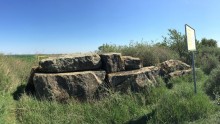|
|
|
|
Steinerne HütteChambered Tomb
|
||||||||||||||||||
|
|
|
Images (click to view fullsize) |
|
Photographs:



 Maps / Plans / Diagrams:
Maps / Plans / Diagrams:
|
Fieldnotes |
|
|
The tomb is located halfway between Latdorf and Borgesdorf south of the L73 directly east on a dirt road. The tomb has a northeast-southwest oriented, slightly trapezoidal burial chamber with a length of about 7 m and a width of about 2.5 m. It is not built of granite boulders, but of sandstone slabs. The tomb is still relatively well preserved. Three capstones are still present, an access to the burial chamber is not visible. In the summer, the grave is probably overgrown and difficult to photograph especially from the east. You drive from Latdorf on the L64 in the direction of Gerbitz. Approximately 450 m behind Latdorf, turn left onto the L73 in the direction of Borgesdorf. The road leads first to the southeast and then after about 700 m east around a lime dump around. Shortly before the road makes another bend, turn right into a dirt road. Here you can park or carry on about 150 meters before the grave is immediately left of the dirt road. Visited April 2019 |
19th May 2019ce |
|
taken from the information board Arbeitskreis Archäologie im Bernburger Land e.V.: Steinerne Hütte (Stone Hut) Middle Neolithic period: approx. 4,100 - 2,700 BC The Steinerne Hütte is a burial ground that was built in the middle Neolithic period (about 4,100 - 2,700 BC) by the people of the so-called funnel beaker culture (in our area so by representatives of the Baalberger and the Bernburg culture). Such giant's grave (megalithic tombs) were widespread in large parts of western, northern and central Europe, with the known megalithic tombs in the Bernberg-Köthen area belong to the southernmost representatives. The imposing construction of the megalithic tomb (length: approx. 8 m, width: approx. 2 m, height: approx. 1.5 m) was reconstructed in 1958 by the state museum of prehistory Halle / Saale. It was constructed from cut sandstone slabs. In addition to the 10 support stones and 5 cover plates, several upright limestone plates have been preserved in the northwestern part of the burial chamber as well as remains of a floor plaster. The tomb was formerly probably covered by a hill. Unfortunately, its removal took place at a time when archaeological findings were neither observed nor documented, in the present case probably before the 19th century. A consideration is based here on a destruction of the hill in the Thirty Years' War, when in the fall of 1644 around Latdorf a huge Swedish army camp was built, for whose fortifications one could use the soil well. In addition, in 1918, the improper opening of the excavated burial chamber was said to have occurred, with all finds lost. As a result, in the present case, we have no information on the findings. Readings (pottery shards and flint tools), which were made in connection with security work and site inspections, however, date safely to the Neolithic period. Due to the characteristic construction and numerous comparable findings it can be assumed that the people of the above-mentioned Baalberger or the Bernburg culture were the builders of the megalithic grave, and probably also subsequent uses by later cultures, such as in the Bronze Age, took place. |
19th May 2019ce Edited 5th June 2019ce |

